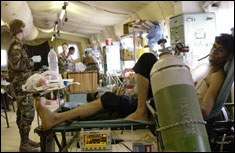|
This video was produced by the US
Army in 1992 to assist in instructing medical providers in the
examination of the chest.
Topics include inspection, palpation and percussion, appropriate for
training Army Medics,
Navy Hospital Corpsmen, or
Emergency Medical Technicians.
The video may be freely
downloaded.
|

THE EXAMINATION:
Proceed in an orderly way beginning with a complete exam of the
posterior chest first, followed by the anterior chest.
-
Inspect: Look for
deformity, retractions with inspirations, or a displaced trachea.
Observe rate, depth and effort of breathing. Listen for wheezes,
etc.
-
Palpation: Check for areas
of pain, masses, and feel for the movement of the chest on deep
inspiration. Palpate for tactile fremitus (vibrations felt through
the chest wall by palpation). Using your palm at the base of the
fingers palpate having the patient repeat the words "ninety-nine".
Fremitus is decreased with pnuemothorax and increased when
transmission of sound is increased as though consolidated lung of
lobar pneumonia.
-
Percussion is used to
determine if the underlying tissues are air or fluid filled or
solid. Using the middle finger's distal joint press firmly on the
chest keeping the rest of the hand off. Then strike the DIP joint
with your other middle finger tip-movement is from the wrist. Normal
lung tissue is resonant. The liver sound is dull. The lungs sound
dull when fluid replaces air in the lungs as in pneumonia with
infiltrate or with hemothorax. Percuss for diaphragmatic excursion,
compare the level of the dullness on full expiration and full
inspiration, usually moves up and down 5-6 cm.
-
Ausculatation of lung
fields: Abnormal breath sounds of the lungs are of two types:
-
Crackles (old name was
rales): are intermittent, non-musical, very brief sounds. They
sound like rubbing hair between your fingers. Notice if they are
heard on inspiration or expiration. These sounds are produced when
previously closed airways open suddenly in the smaller airways.
-
Continuous or of longer
duration then crackles with a musical sound. There are of two
types:
-
Wheezes: High pitched
musical sound caused by relatively high velocity air flow
through a narrowed airway.
-
Rhonci: Deeper, have a
snoring quality, caused by the passage of through an airway
obstructed by secretions. Tend to disappear after coughing.
Now repeat the examination on
the anterior chest:
-
Inspect chest
-
Palpation of chest
-
Palpation of tactile
fremitus
-
Percussion of anterior
thorax
-
Auscultation of anterior
chest
From
the Hospital Corpsman Sickcall Screeners Handbook
Naval Hospital, Great Lakes
April, 1999 |

